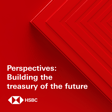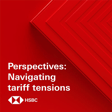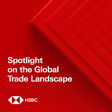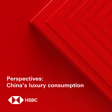Become a Creator today!Start creating today - Share your story with the world!
Start for free
00:00:00
00:00:01

The ESG Brief – Untangling the returns knot
In this edition, the team focuses on a big problem for the apparel industry: millions of returned goods are ending up in landfills and incinerators. Plus, we look at the sector's executive pay policies and whether they encourage sustainability.
Disclaimer: https://www.research.hsbc.com/R/61/RlZpgGb Stay connected and access free to view reports and videos from HSBC Global Research follow us on LinkedIn https://www.linkedin.com/feed/hashtag/hsbcresearch/ or click here: https://www.gbm.hsbc.com/insights/global-research.
Hosted on Acast. See acast.com/privacy for more information.
Transcript
Introduction and Disclaimers
00:00:02
Speaker
Welcome to HSBC Global Viewpoint, the podcast series that brings together business leaders and industry experts to explore the latest global insights, trends, and opportunities.
00:00:13
Speaker
Make sure you're subscribed to stay up to date with new episodes.
00:00:16
Speaker
Thanks for listening.
00:00:17
Speaker
And now onto today's show.
00:00:23
Speaker
The following podcast was recorded for distribution on the 9th of October.
00:00:27
Speaker
All the disclosures and disclaimers associated with it must be viewed on the link attached to your media player.
Introduction to ESG Brief
00:00:36
Speaker
Hello everybody and a warm welcome to the ESG Brief where we showcase some of the most noteworthy work coming from the team here at HSBC Global Research on environmental, social and governance issues.
Impact of Online Returns
00:00:48
Speaker
I'm your host Jack Reed.
00:00:50
Speaker
This edition is all about returns from consumers ordering things online and then sending them back for one reason or another.
00:00:58
Speaker
Millions of dresses and suits, sweaters and sweatshirts are ending up in landfills or incinerators.
00:01:06
Speaker
Deferred payment plans and other options today make it easier than ever for consumers to buy now and return later.
00:01:14
Speaker
The rate of returns in apparel also has a potential impact on the industry's profit margins and we'll be exploring that as well as our most recent research on the extent to which boardroom pay and bonuses in the retail sector is linked to performance on sustainability issues.
00:01:35
Speaker
To help me untangle this returns problem, I'm joined by ESG analyst Amy Tyler, corporate governance analyst Yarina Koble, and the head of European consumer retail research, Paul Rosington.
00:01:47
Speaker
Amy, let me turn to you first.
00:01:49
Speaker
What's the environmental impact of online return policies that you've been investigating in your latest research?
00:01:57
Speaker
Absolutely, yes.
00:01:58
Speaker
So the online shopping trend and some of these payment developments have provided this accessible consumption process that has led to overconsumption and this rising returns problem that we are seeing.
00:02:12
Speaker
Some of the environmental impacts are the most daunting here.
00:02:15
Speaker
We have 23 million garments were sent to landfill or incinerated in 2022 in the UK alone and returns generated 750,000 tonnes of CO2 in 2022, majority in warehousing, repackaging and disposal as well.
00:02:32
Speaker
So this is important because 2024 is expected to be the first year that more is bought online than in store in the UK.
00:02:40
Speaker
and we're seeing more retailers move online.
00:02:43
Speaker
What does this problem look like outside the UK?
00:02:46
Speaker
Exactly.
00:02:46
Speaker
One of the issues we're facing is the lack of data on this issue.
00:02:49
Speaker
We know it's such a vast issue, yet these are all estimates and approximations to where these clothes end up.
00:02:56
Speaker
A lot of sold onto third parties where transparency about the end life of these garments is not there.
00:03:03
Speaker
And transparency obviously being an important factor for investors to be taking into account.
00:03:08
Speaker
Absolutely, and the circularity of garments, as in making garments that can then be recycled, repaired, and extending the life of garments, understanding where they end up, so that we have a more sustainable fashion industry.
Financial Strain on Retailers
00:03:21
Speaker
So we have a good concept in circularity, but nothing really seems terribly circular in this practice.
00:03:28
Speaker
Exactly.
00:03:29
Speaker
We're seeing a lot of waste and a lot of emissions and environmental impact, such as biodiversity and human health impacts that come from landfills and incinerating garments.
00:03:38
Speaker
Paul, we've talked about the actual returns of apparel.
00:03:42
Speaker
Can you describe the impact of this situation on the financial returns?
00:03:47
Speaker
Absolutely.
00:03:47
Speaker
So if you look at the pure play online retailers who are most at risk of returns because they don't have physical stores through which to return and sell garments themselves, returns can vary from anywhere between 30 and 50 percent of the gross sales of a company.
00:04:02
Speaker
And that's an awful lot of product to be returned back to the retailer, and it has to be returned at a cost.
00:04:07
Speaker
Some of those returns are coming from issues regarding wardrobing or bracketing, which we can discuss later, changes in consumer trends, but the reality is there is a cost to the convenience of having superior choice and fulfillment options online.
00:04:21
Speaker
And a number of these pure-play online retailers offer free delivery and free return, or subscription passes which allow, at the extreme, a small segment of customers to overorder substantially and return substantially more product than average.
00:04:34
Speaker
And that has a negative impact on your basket economics as a purely online retailer and by default has a negative impact on your financial returns.
00:04:42
Speaker
So from a revenue perspective, some of these returns can look quite good.
00:04:46
Speaker
On the other hand, eventually these products are coming back and they're being thrown away.
00:04:51
Speaker
Absolutely.
00:04:52
Speaker
And the higher the percentage of goods that are being returned, the higher the incremental cost that company has to absorb.
00:04:58
Speaker
If it's offering free delivery, free return, the higher the incremental cost it has to absorb before it can actually generate a profit.
00:05:05
Speaker
Are we talking about all retailers who are doing internet sales?
00:05:09
Speaker
So, pure play online retailers are most exposed because they only have one medium by which to distribute product, typically direct to the consumer, including last mile fulfillment, or to have that product returned.
00:05:22
Speaker
And these would be companies like what, for example?
00:05:25
Speaker
Companies, for example, would be Zalando at a European level, Asus, or even an Amazon, for example, at a global level.
00:05:32
Speaker
The other retailers would be omnichannel retailers.
00:05:34
Speaker
So these would be companies which have a store and an online based channels to market.
00:05:38
Speaker
And if you do have the store base in place, that offers a different or an alternative option by which to fulfill orders or to receive orders back from
Consumer Behavior and Return Rates
00:05:48
Speaker
the consumer.
00:05:48
Speaker
And that is a less disruptive, less costly way of doing it because it typically cuts out the last mile fulfillment or last mile return part of that journey.
00:05:56
Speaker
And that's typically the most expensive part of any fulfillment journey.
00:06:00
Speaker
The reality is at the end of the day the consumer will shop the way they want to shop.
00:06:04
Speaker
Actually for an omnichannel retailer the ability to offer that consumer more points of contact either online or in the store is actually a revenue generating opportunity for that omnichannel retailer.
00:06:17
Speaker
But to try and force the consumer down any individual channel comes with inherent risks itself.
00:06:23
Speaker
So how did we end up in this mess, Amy?
00:06:25
Speaker
30% to 50% of the clothing being sold online is being returned, and a staggering number of clothing items are literally being tossed into the trash.
00:06:39
Speaker
Yes, there's a lot of these fast fashion trends that we talk about, specifically for the returns problem, the sizing and the fit, the inconsistency there, and also the quality.
00:06:51
Speaker
When quality is not matched what a consumer expects, returns tend to increase.
00:06:56
Speaker
Also, we spoke about the wardrobing and bracketing.
00:06:58
Speaker
So what these are is wardrobing is when you wear an item with the tags and you return it or you wear it to post on social media, for example, and return the item.
00:07:09
Speaker
And the bracketing is where you order in multiple sizes or colours and then return the ones that don't fit or don't fit.
00:07:15
Speaker
So you're using your home as a changing room like you would in store and then this is increasing number of turns.
00:07:23
Speaker
The inconsistency in sizing has also meant that across brands you will be different sizes which is making it harder to choose the items and therefore increasing number of returns.
00:07:35
Speaker
It is a big problem which goes to outlining the complexity of returns, both from a handling and a processing perspective, and the incremental cost, because it is a significant chunk of the gross sales of any pure play online retailer or any omnichannel retailer with a meaningful online channel to market.
00:07:53
Speaker
And just to put that into perspective, most of the omnichannel retailers we look at, whether that's a Marks & Spencers or a Next or a Zara, are already generating the best part of a quarter of their sales.
00:08:03
Speaker
online where returns are typically highest is where you have companies that offer a multi-brand platform so that could be a retailer like a Zalando which is retailing up to 7,000 different brands across the various territories where they operate you've got a huge number of brands with different sizing measurements no two brands are necessarily the same a size 10 and a pair of Nike shoes might not be the same size 10 and a pair of Adidas shoes for example so sizing inconsistencies there
00:08:32
Speaker
Also, for retailers who have a higher proportion of fit critical garments, and by that I'm referring to dresses or occasion wear suits for men for example, you have a higher returns rates attached to those products than you would for example against a pair of jogging pants or a running top which typically comes in a small, medium or large rather than a multitude of different fits to make sure that you are getting that right occasion wear product.
00:09:00
Speaker
Amy, what solutions
Solutions to Reduce Returns
00:09:01
Speaker
do you see here?
00:09:01
Speaker
How do you overcome the fact that 84% of consumers expect returns to be free?
00:09:07
Speaker
Yes, so we have two direct solutions.
00:09:09
Speaker
This is returns avoidance, so aiming to reduce the potential for returns at the point of sale, and also returns handling, where you optimize this reverse logistics and operations processes to handle these returns more efficiently.
00:09:24
Speaker
So the returns charges actually comes under the avoidance.
00:09:28
Speaker
So this is a method retailers can use to avoid some of these returns happening.
00:09:32
Speaker
And as you say, the majority of consumers believe all returns should be free.
00:09:36
Speaker
So although this is attractive for the consumer, retailers do bear the brunt of the cost and are discouraged to implement these avoidance methods.
00:09:44
Speaker
So we do suggest other options such as improving the product representation.
00:09:49
Speaker
So helping the consumer choose the product is useful so that retailers can reduce the returns problem, especially for the size and fit and quality issues we're seeing.
00:09:58
Speaker
So these could be improving product descriptions, 360 degree views, size calculators, and also more diverse model photos.
00:10:09
Speaker
Okay, you're touching on some things here that have technological solutions potentially.
00:10:14
Speaker
Absolutely.
00:10:15
Speaker
Technology has a key role to play here.
00:10:17
Speaker
We have virtual reality, which can really help a consumer identify which product will suit them best, and also AI as well in the consumer end of this problem.
00:10:27
Speaker
But the obvious solution would seem to be that consumers are penalized when they return something they've ordered online, despite the fact they don't want to pay for the privilege.
00:10:35
Speaker
Yes, that's absolutely correct.
00:10:36
Speaker
I think what you're actually seeing right now is a trend of more and more retailers, both pure play and omnichannel retailers, introducing returns fees for online deliveries back to the distribution center.
00:10:49
Speaker
In the case of omnichannel, if you return to store, it's still typically free because there is no cost incurred by the retailer there.
00:10:56
Speaker
But actually seeing more returns charges for online orders going back via mail, Royal Mail, UPS, etc.
00:11:01
Speaker
coming in.
00:11:02
Speaker
It's an economic necessity in some cases for retailers who are looking to recoup some of those costs of facilitating returns.
00:11:09
Speaker
They're also using it quite deliberately as a way of trying to discourage consumers from spending too much, over-consuming and returning more than they need to.
Investor Focus on Sustainable Growth
00:11:18
Speaker
I think there's an element of that as well.
00:11:20
Speaker
But the reality is going forward we're expecting more returns to charges to come in because that is really the only way that they are going to be able to cut back on the number of returns coming in any real shape or form.
00:11:32
Speaker
I think in the report we've actually made the point that where better size and fitting has been used and this has been something that a lot of online retailers have tried to use for a long time to help bring returns down.
00:11:42
Speaker
They've had selective success on certain lines but it's not been a game changer as yet.
00:11:48
Speaker
So we think more returns charges going forward is going to be the cause for the industry as a whole.
00:11:52
Speaker
And the consumer will have to get used to the fact that if they want the convenience of accessing more choice online and they want the convenience of those additional fulfillment options, that is going to come at a cost.
00:12:03
Speaker
So where should investors be focusing their attention?
00:12:06
Speaker
So from a sustainability perspective and from an investor perspective, there's now a greater focus on delivering growth at the right cost rather than growth at any cost, which was very much the trend we saw pre-pandemic.
00:12:18
Speaker
Coming out of the pandemic, investors now more focused on not just top line growth, which is which could be considered something of a vanity exercise pre pandemic, but actually delivering that growth at the right price and delivering a sustainable and acceptable profit margin at the same time.
HSBC Podcasts Overview
00:12:34
Speaker
And so you're seeing a lot of online retailers and other online businesses like delivery, for example, focusing on delivering margins as well as top line growth.
00:12:43
Speaker
And they'll sacrifice that top line growth to hit the right margin number.
00:12:47
Speaker
And that comes with better ethical practice and reducing some of these returns issues, which are high cost, cutting out consumers who over consume, return too much and by default destroy the profitability of these platforms.
00:13:06
Speaker
A quick reminder before we carry on, the ESG Brief is one of three regular podcasts produced by the team here at HSBC Global Research, alongside our weekly macro brief and our weekly focus from Asia called Under the Banyan Tree.
Linking Executive Pay to Sustainability
00:13:21
Speaker
All three podcasts are available on your podcast platform of choice, including Apple and Spotify.
00:13:27
Speaker
Now, let's bring corporate governance into the discussion on returns with Yarina Kobel, our governance analyst, who's been looking at sustainability-linked executive pay policies and whether they are or could help drive company performance.
00:13:42
Speaker
Yarina, welcome.
00:13:44
Speaker
Thanks, Jack.
00:13:45
Speaker
So whose pay and sustainability practices have you been looking at here?
00:13:51
Speaker
We examined the policies of apparel companies included in the FTSE Europe Index.
00:13:58
Speaker
Apparel firms globally are increasingly linking executive pay to sustainability measures, but we focused on European firms because they provide more detailed disclosures compared to their peers in other regions.
00:14:13
Speaker
All 13 companies we looked at have sustainability policies and clear targets in place.
00:14:20
Speaker
Also, all of them have performance-based elements in executive pay.
00:14:26
Speaker
And 10 firms use sustainability metrics in variable pay.
00:14:31
Speaker
Is it a good thing that 10 out of the 13 have these metrics?
00:14:36
Speaker
Well, you can say it's a good thing, but our concern is around sustainability washing, or in other words, that these metrics may have limited impact on the final pay outcomes.
00:14:49
Speaker
So, eight of the companies we looked at apply a scorecard approach to variable pay.
00:14:57
Speaker
It means that sustainability metrics do not have an individual weighting, but form part of a mix of measures, which may also include a number of other strategic or operational criteria.
00:15:12
Speaker
And the Remuneration Committee has discretion what to include and how to assess achievements and there are often no clear assessment criteria disclosed.
00:15:24
Speaker
As a result, for some companies, according to our calculations, economic significance of sustainability-based pay may account for only 1-2% of total on-target compensation for the year.
00:15:39
Speaker
So there's a risk that some of these sustainability metrics can get lost.
00:15:44
Speaker
Yes, indeed, with this approach.
00:15:46
Speaker
So what do investors need to do?
00:15:49
Speaker
We think investors need to be vigilant.
00:15:53
Speaker
They should ask companies how they incorporate sustainability dimensions into pay.
00:15:59
Speaker
Among the companies we looked at a couple tie 15% to 20% of pay incentive to sustainability measures and we think this approach is most effective.
00:16:16
Speaker
Also, clear focus on why these metrics have been included is vital, as this helps motivate executives to focus on the factors of key importance, for example, on the returns problems we have been discussing here.
Closing Remarks
00:16:32
Speaker
Irina, Paul, and Amy, thank you very much for your time.
00:16:37
Speaker
Super interesting reports from you.
00:16:40
Speaker
That's the ESG Brief for this edition.
00:16:42
Speaker
We'll be back soon.
00:17:04
Speaker
Thank you for joining us at HSBC Global Viewpoint.
00:17:08
Speaker
We hope you enjoyed the discussion.
00:17:10
Speaker
Make sure you're subscribed to stay up to date with new episodes.

















